Javier Alonso-Mora
Delft University of Technology
Global End-Effector Pose Control of an Underactuated Aerial Manipulator via Reinforcement Learning
Dec 24, 2025Abstract:Aerial manipulators, which combine robotic arms with multi-rotor drones, face strict constraints on arm weight and mechanical complexity. In this work, we study a lightweight 2-degree-of-freedom (DoF) arm mounted on a quadrotor via a differential mechanism, capable of full six-DoF end-effector pose control. While the minimal design enables simplicity and reduced payload, it also introduces challenges such as underactuation and sensitivity to external disturbances, including manipulation of heavy loads and pushing tasks. To address these, we employ reinforcement learning, training a Proximal Policy Optimization (PPO) agent in simulation to generate feedforward commands for quadrotor acceleration and body rates, along with joint angle targets. These commands are tracked by an incremental nonlinear dynamic inversion (INDI) attitude controller and a PID joint controller, respectively. Flight experiments demonstrate centimeter-level position accuracy and degree-level orientation precision, with robust performance under external force disturbances. The results highlight the potential of learning-based control strategies for enabling contact-rich aerial manipulation using simple, lightweight platforms.
Cross-Entropy Optimization of Physically Grounded Task and Motion Plans
Dec 12, 2025Abstract:Autonomously performing tasks often requires robots to plan high-level discrete actions and continuous low-level motions to realize them. Previous TAMP algorithms have focused mainly on computational performance, completeness, or optimality by making the problem tractable through simplifications and abstractions. However, this comes at the cost of the resulting plans potentially failing to account for the dynamics or complex contacts necessary to reliably perform the task when object manipulation is required. Additionally, approaches that ignore effects of the low-level controllers may not obtain optimal or feasible plan realizations for the real system. We investigate the use of a GPU-parallelized physics simulator to compute realizations of plans with motion controllers, explicitly accounting for dynamics, and considering contacts with the environment. Using cross-entropy optimization, we sample the parameters of the controllers, or actions, to obtain low-cost solutions. Since our approach uses the same controllers as the real system, the robot can directly execute the computed plans. We demonstrate our approach for a set of tasks where the robot is able to exploit the environment's geometry to move an object. Website and code: https://andreumatoses.github.io/research/parallel-realization
Studying the Effect of Explicit Interaction Representations on Learning Scene-level Distributions of Human Trajectories
Nov 06, 2025Abstract:Effectively capturing the joint distribution of all agents in a scene is relevant for predicting the true evolution of the scene and in turn providing more accurate information to the decision processes of autonomous vehicles. While new models have been developed for this purpose in recent years, it remains unclear how to best represent the joint distributions particularly from the perspective of the interactions between agents. Thus far there is no clear consensus on how best to represent interactions between agents; whether they should be learned implicitly from data by neural networks, or explicitly modeled using the spatial and temporal relations that are more grounded in human decision-making. This paper aims to study various means of describing interactions within the same network structure and their effect on the final learned joint distributions. Our findings show that more often than not, simply allowing a network to establish interactive connections between agents based on data has a detrimental effect on performance. Instead, having well defined interactions (such as which agent of an agent pair passes first at an intersection) can often bring about a clear boost in performance.
From Data to Safe Mobile Robot Navigation: An Efficient and Modular Robust MPC Design Pipeline
Aug 09, 2025Abstract:Model predictive control (MPC) is a powerful strategy for planning and control in autonomous mobile robot navigation. However, ensuring safety in real-world deployments remains challenging due to the presence of disturbances and measurement noise. Existing approaches often rely on idealized assumptions, neglect the impact of noisy measurements, and simply heuristically guess unrealistic bounds. In this work, we present an efficient and modular robust MPC design pipeline that systematically addresses these limitations. The pipeline consists of an iterative procedure that leverages closed-loop experimental data to estimate disturbance bounds and synthesize a robust output-feedback MPC scheme. We provide the pipeline in the form of deterministic and reproducible code to synthesize the robust output-feedback MPC from data. We empirically demonstrate robust constraint satisfaction and recursive feasibility in quadrotor simulations using Gazebo.
A Vehicle System for Navigating Among Vulnerable Road Users Including Remote Operation
May 08, 2025



Abstract:We present a vehicle system capable of navigating safely and efficiently around Vulnerable Road Users (VRUs), such as pedestrians and cyclists. The system comprises key modules for environment perception, localization and mapping, motion planning, and control, integrated into a prototype vehicle. A key innovation is a motion planner based on Topology-driven Model Predictive Control (T-MPC). The guidance layer generates multiple trajectories in parallel, each representing a distinct strategy for obstacle avoidance or non-passing. The underlying trajectory optimization constrains the joint probability of collision with VRUs under generic uncertainties. To address extraordinary situations ("edge cases") that go beyond the autonomous capabilities - such as construction zones or encounters with emergency responders - the system includes an option for remote human operation, supported by visual and haptic guidance. In simulation, our motion planner outperforms three baseline approaches in terms of safety and efficiency. We also demonstrate the full system in prototype vehicle tests on a closed track, both in autonomous and remotely operated modes.
Pushing Through Clutter With Movability Awareness of Blocking Obstacles
Feb 27, 2025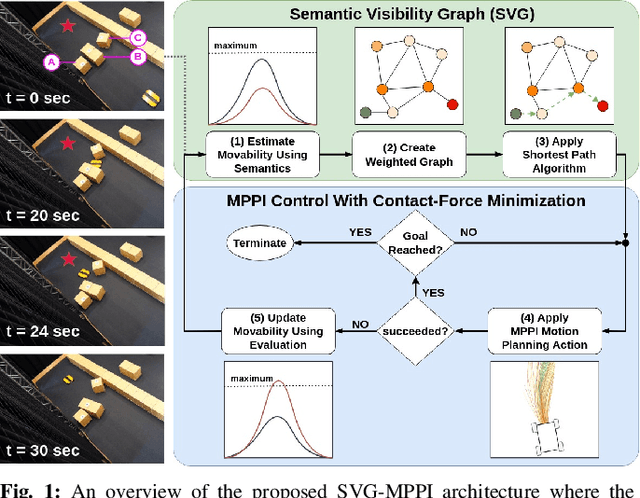
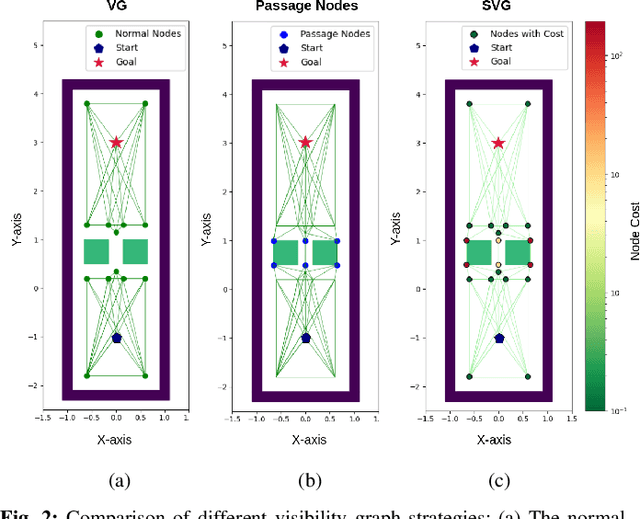
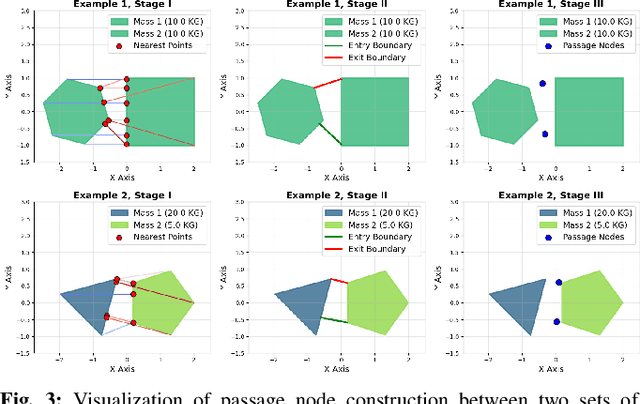
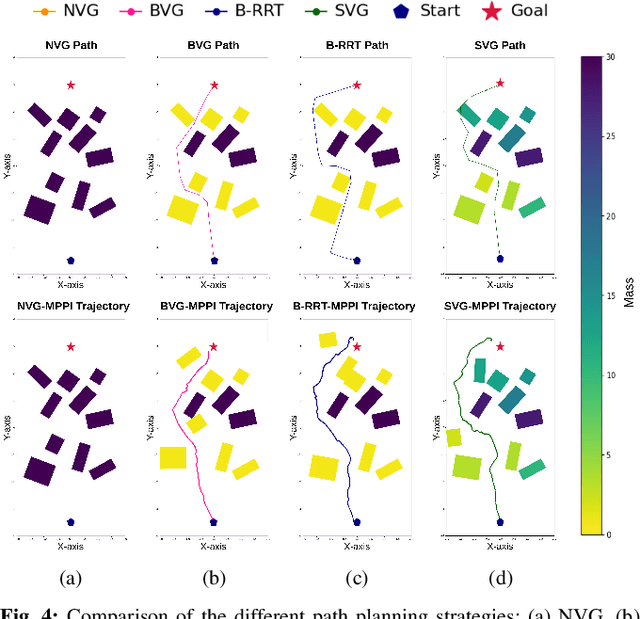
Abstract:Navigation Among Movable Obstacles (NAMO) poses a challenge for traditional path-planning methods when obstacles block the path, requiring push actions to reach the goal. We propose a framework that enables movability-aware planning to overcome this challenge without relying on explicit obstacle placement. Our framework integrates a global Semantic Visibility Graph and a local Model Predictive Path Integral (SVG-MPPI) approach to efficiently sample rollouts, taking into account the continuous range of obstacle movability. A physics engine is adopted to simulate the interaction result of the rollouts with the environment, and generate trajectories that minimize contact force. In qualitative and quantitative experiments, SVG-MPPI outperforms the existing paradigm that uses only binary movability for planning, achieving higher success rates with reduced cumulative contact forces. Our code is available at: https://github.com/tud-amr/SVG-MPPI
Agile and Cooperative Aerial Manipulation of a Cable-Suspended Load
Jan 30, 2025



Abstract:Quadrotors can carry slung loads to hard-to-reach locations at high speed. Since a single quadrotor has limited payload capacities, using a team of quadrotors to collaboratively manipulate a heavy object is a scalable and promising solution. However, existing control algorithms for multi-lifting systems only enable low-speed and low-acceleration operations due to the complex dynamic coupling between quadrotors and the load, limiting their use in time-critical missions such as search and rescue. In this work, we present a solution to significantly enhance the agility of cable-suspended multi-lifting systems. Unlike traditional cascaded solutions, we introduce a trajectory-based framework that solves the whole-body kinodynamic motion planning problem online, accounting for the dynamic coupling effects and constraints between the quadrotors and the load. The planned trajectory is provided to the quadrotors as a reference in a receding-horizon fashion and is tracked by an onboard controller that observes and compensates for the cable tension. Real-world experiments demonstrate that our framework can achieve at least eight times greater acceleration than state-of-the-art methods to follow agile trajectories. Our method can even perform complex maneuvers such as flying through narrow passages at high speed. Additionally, it exhibits high robustness against load uncertainties and does not require adding any sensors to the load, demonstrating strong practicality.
RPCBF: Constructing Safety Filters Robust to Model Error and Disturbances via Policy Control Barrier Functions
Oct 15, 2024Abstract:Control Barrier Functions (CBFs) have proven to be an effective tool for performing safe control synthesis for nonlinear systems. However, guaranteeing safety in the presence of disturbances and input constraints for high relative degree systems is a difficult problem. In this work, we propose the Robust Policy CBF (RPCBF), a practical method of constructing CBF approximations that is easy to implement and robust to disturbances via the estimation of a value function. We demonstrate the effectiveness of our method in simulation on a variety of high relative degree input-constrained systems. Finally, we demonstrate the benefits of RPCBF in compensating for model errors on a hardware quadcopter platform by treating the model errors as disturbances. The project page can be found at https://oswinso.xyz/rpcbf.
Particle-based Instance-aware Semantic Occupancy Mapping in Dynamic Environments
Sep 18, 2024
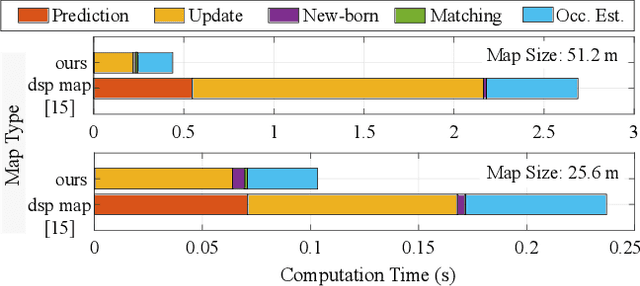
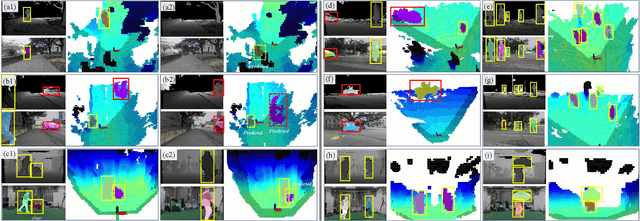
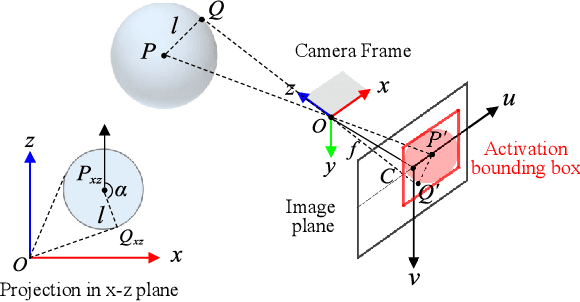
Abstract:Representing the 3D environment with instance-aware semantic and geometric information is crucial for interaction-aware robots in dynamic environments. Nonetheless, creating such a representation poses challenges due to sensor noise, instance segmentation and tracking errors, and the objects' dynamic motion. This paper introduces a novel particle-based instance-aware semantic occupancy map to tackle these challenges. Particles with an augmented instance state are used to estimate the Probability Hypothesis Density (PHD) of the objects and implicitly model the environment. Utilizing a State-augmented Sequential Monte Carlo PHD (S$^2$MC-PHD) filter, these particles are updated to jointly estimate occupancy status, semantic, and instance IDs, mitigating noise. Additionally, a memory module is adopted to enhance the map's responsiveness to previously observed objects. Experimental results on the Virtual KITTI 2 dataset demonstrate that the proposed approach surpasses state-of-the-art methods across multiple metrics under different noise conditions. Subsequent tests using real-world data further validate the effectiveness of the proposed approach.
Embedded Hierarchical MPC for Autonomous Navigation
Jun 17, 2024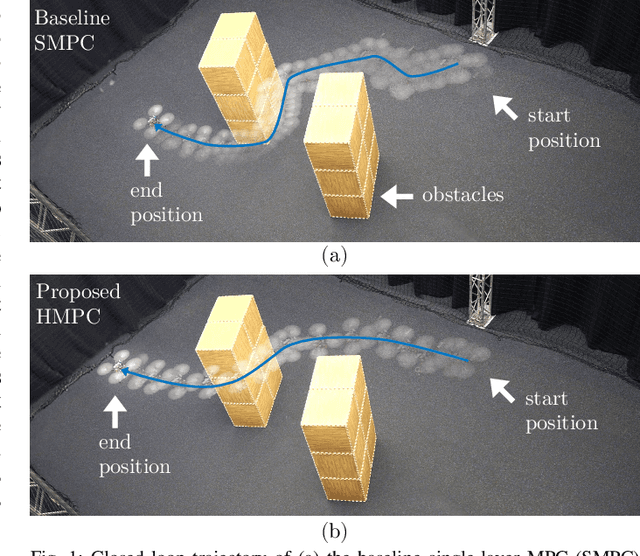
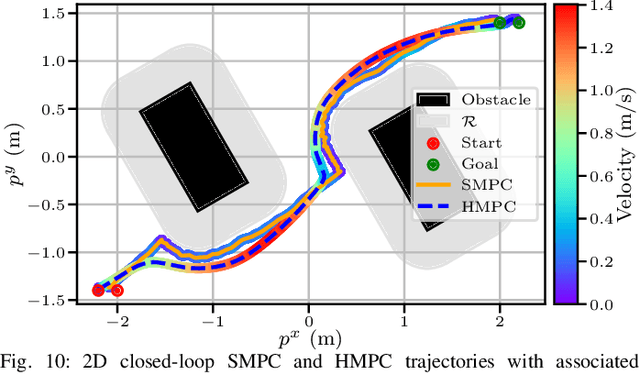
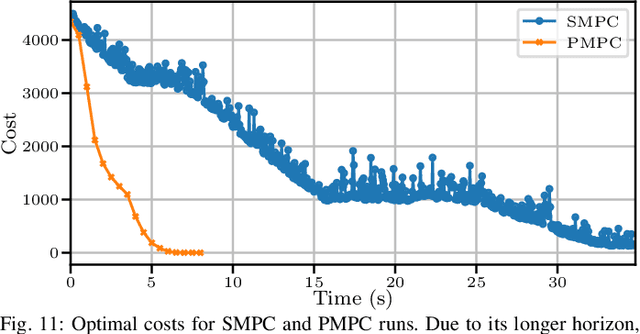
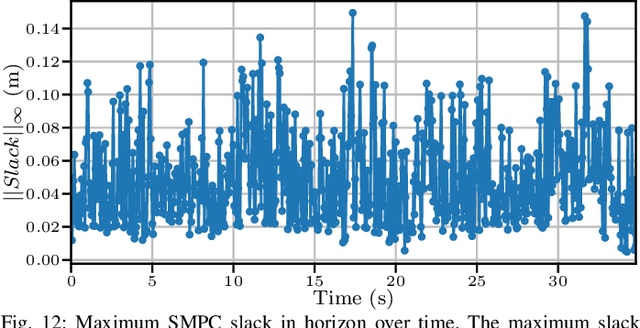
Abstract:To efficiently deploy robotic systems in society, mobile robots need to autonomously and safely move through complex environments. Nonlinear model predictive control (MPC) methods provide a natural way to find a dynamically feasible trajectory through the environment without colliding with nearby obstacles. However, the limited computation power available on typical embedded robotic systems, such as quadrotors, poses a challenge to running MPC in real-time, including its most expensive tasks: constraints generation and optimization. To address this problem, we propose a novel hierarchical MPC scheme that interconnects a planning and a tracking layer. The planner constructs a trajectory with a long prediction horizon at a slow rate, while the tracker ensures trajectory tracking at a relatively fast rate. We prove that the proposed framework avoids collisions and is recursively feasible. Furthermore, we demonstrate its effectiveness in simulations and lab experiments with a quadrotor that needs to reach a goal position in a complex static environment. The code is efficiently implemented on the quadrotor's embedded computer to ensure real-time feasibility. Compared to a state-of-the-art single-layer MPC formulation, this allows us to increase the planning horizon by a factor of 5, which results in significantly better performance.
 Add to Chrome
Add to Chrome Add to Firefox
Add to Firefox Add to Edge
Add to Edge